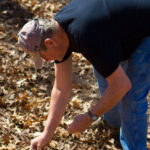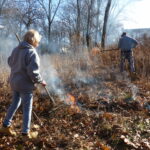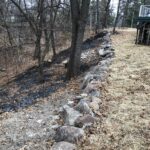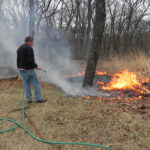by Winding Pathways | Mar 12, 2020 | (Sub)Urban Homesteading, Garden/Yard, Garden/Yard
Like millions of Americans who live in rural or semi-rural areas we don’t have access to a city sewer and rely on our septic tank to safely dispose of waste. We’re lucky at Winding Pathways. Our home is built on an ancient sand dune with steep topography. It’s perfect for a septic system.

We put scraps that chickens will not eat into the compost bin.
As a review, we’ve been spared septic tank problems because we treat our system carefully. Here’s what we do:
- Only human and sink waste goes down the drain. Potato peels, apple cores, and all other food waste go either to our chickens or into the compost bin. Spring and fall, we work the compost into the garden soil.
- Have our tank pumped every three or four years.
- Avoid draining harsh chemicals, like bleach and solvents, into the tank.
- Use water-efficient toilets, showerheads, and sink aerators to limit the amount of water going into the tank.
In August 2019, we blogged in detail about maintaining a septic system. Since then, many readers have come to that blog. Especially this winter. So, we are curious.
What brings you to Winding Pathways? What topics interest you most? Why? What else would you like to read about?
Thanks for keeping us company on Winding Pathways and happy reading as winter winds down and spring manifests itself across the Northern Hemisphere.
by Winding Pathways | Mar 5, 2020 | (Sub)Urban Homesteading, Chickens

Even healthy-looking chickens can die suddenly.
Our chickens aren’t really pets. We don’t give them names and every once in a while, we sell or give away a few. Even so, we get attached to our hens as we recognize their individual personalities and enjoy their antics.
Maybe it’s silly but we feel sad when one dies. That happened recently when we went into our coop to find one of our Buff Brahmas moping. She was huddled in a corner crouched down into the sawdust litter. The next morning, she was dead.
We carefully examined her and learned she was well fleshed and had no obvious signs of either disease or injury. We’ll never know what caused her untimely death but over the years we’ve developed a procedure we use when a chicken dies. Here’s what we do:
- Carefully remove the dead bird and dispose of its body. We usually either bury it or gently carry it down in the woods and let nature recycle it. Often a raccoon makes a meal of her the first night. Most municipal waste disposal companies will allow putting an animal carcass in the trash if it’s bagged in three layers of plastic.
- Watch the flock for any sign of disease. If more than one bird dies in a short time, we suspect a disease. We would quickly change out litter, sanitize feeders and waterers and consider taking a bird to the vet. But actually, we can’t remember ever having a disease take a second bird.
We’re careful to protect our flock from disease and practice bio sanitation. Isolation is the best way to keep disease at bay, so we rarely introduce an outside bird to the flock. Because we don’t want to introduce disease, we change clothes and wash up after visiting another flock and before going to our chickens.
Remember to always wash carefully after handling chickens, eggs, feed, or even visiting the coop.
Given nutritious food, protection from dampness and drafts, and practicing biosecurity makes it likely that a backyard flock will stay disease-free, but occasionally a chicken dies. Yup, it’s always sad and it’s part of keeping a flock.
by Winding Pathways | Feb 20, 2020 | (Sub)Urban Homesteading, Garden/Yard, Garden/Yard, Labyrinths, Nature
When we moved into our home ten years ago, we ended up with more than a house. The former owner had regularly mowed most of our two acres. Within the next two years, we shrank the lawn by about half. A steep former lawn north of the house is now prairie and a fairly level quarter acre between our house and the road is Marion’s labyrinth that she created within a prairie we planted.
Today, most people call flower-studded prairies “pollinator patches” and interest is strong in transforming lawns into them. Here are just a few of the good reasons:
Why Plant Pollinator Patches?
- Color: Lawns are a monoculture of green. Pollinator patches feature three seasons worth of changing vibrant color as many species of wildflowers come into and go out of bloom. They are beautiful.
- Water: Closely mowed lawns don’t absorb rain well. Much of a storm’s water runs off, worsening flooding. In contrast, deep-rooted prairies channel most of a storm’s water into the soil, where it eventually recharges the water table and doesn’t worsen downstream flooding.
- Labor: We don’t enjoy endless hours walking behind a lawnmower. We will mow our newly planted prairie two or three times this summer and in the following years, we won’t mow it at all. The lawn takes about a dozen mows a year. So, we’re saving time and mower gas that costs money and creates carbon dioxide.
- Wildlife: We love watching our wren pairs forage for insects in our pollinator patches. By expanding our prairie we’ll welcome even more beautiful and interesting beneficial wild animals to our yard.
Partnerships Work!
Our new prairie will be close to busy 30th St. Drive, so motorists cruising by will see the land transform. We’re partnering the project with the Monarch Research Project, Linn County Roadsides, Sustainable Landscape Solutions, and Pheasants Forever.
Many people want to create pollinator patches in their yards but don’t know how to do this. We will be blogging through the process to help folks know how this is done. Stay tuned and keep visiting www.windingpathways.com to learn how.
-

-
The heavy, up-slope clay soil will absorb water more efficiently and reduce runoff.
-

-
The crew from Sustainable Landscape Solutions determine soil type
-

-
Winding Pathways, Linn County roadsides, Pheasants Forever, the Monarch Research Project and Pheasant Forever make a strong partnersjhip demonstrating how to improve the quality of the land.
-

-
This year snow covers the lawn.
by Winding Pathways | Feb 6, 2020 | (Sub)Urban Homesteading, Mammals
One February morning I took a short work break and walked through the woods near a parking lot and a busy road. I wasn’t paying attention to where I was walking until I stepped on a hard-pointy object.

Finding a matching pair is unusual.
It was a huge deer antler that a buck had recently dropped. Finding it made my day and converted me into a shed hunter.
Shed hunting is a fun late winter activity that lets anyone hunt deer without the need to buy a hunting license. It is deer hunting without the need to kill an animal.
What is a deer shed?
All male members of the deer family and caribou females grow a new pair of antlers every year. They’re not horns. Sheep and goats grow horns, which stay on their head for life and are made of the same material as human fingernails. Antlers, in contrast, are bones of mostly calcium. They are the only bones that grow outside the body and are nourished by a blood-rich skin called velvet.
Why do deer drop their antlers?
Bucks begin growing antlers around April in most places. By September they are fully formed. They rub their antlers on trees to remove the no longer needed velvet, and the now polished bones are ready for jousts between males to figure out who’s the boss buck. By Christmas a dropping testosterone level causes the antlers to fall off. These “cast” or “shed” antlers can hit the ground as early as Christmas or as late as early April. But February is a prime time to search for them.
Where can I look for deer sheds?
Obviously, the best place to look for sheds is where deer hang out. Tracks, droppings, and actual deer sightings help locate prime places. In this modern era, some of the biggest bucks live in suburban and urban areas, so it’s possible to saunter out into the backyard and find one. Wooded city parks and timbered wooded corridors are also prime spots. Be sure to have permission before venturing on private land.
-

-
Deer walk the same path.
-

-
Sheds can be found where deer rest.
-

-
Follow trails of deer scat when shed hunting.
There’s more to shed hunting than we’re putting in this short blog. An outstanding resource is SHED HUNTING, A Guide To Finding White-Tailed Deer Antlers by Joe Shead (yup that’s his real name, and it’s pronounced “shed). For information check out www.goshedhunting.com/shop.
by Winding Pathways | Jan 30, 2020 | (Sub)Urban Homesteading, Reflections/Profiles
Background
I’ve been a dedicated walker all my life. As a young person wandering the woods, a biologist tromping the Alaskan tundra, a nature center director leading groups of kids afield, and as a birder, backpacker, and cross-country skier I’ve put a lot of miles on my 70-year-old joints. My iPhone says I’ve averaged about 11,000 steps a day for the past four years. If extrapolated backward that’s about 240 million flexes on my knee joints!
Several years ago, my physician treated me for elevated blood pressure (BP) with meds that I didn’t like taking. I asked her if increasing my physical activity might reduce my blood pressure. She said, “Give it a try.” I did and expanded my walking and added some simple daily weight exercises. It worked. After about six months my BP fell into the normal range. I tossed out the meds and kept exercising.
Then an ironic problem arose. In early 2019 my left knee started to hurt. Really hurt. A few months later the right knee followed suit. My doc prescribed an X-Ray that revealed cartilage worn thin. I was caught in a dilemma. If pain caused me to reduce walking, my blood pressure would rise. Not good. Medical science started steering me toward knee replacement. However, I wanted to try other solutions first. Sooner or later knee surgery may be needed but after almost a year of experimenting with ways and places to walk and what shoes are best, I’m able to stay physically active and reduce, but not completely eliminate the knee joint pain.
Pain Meds
My family physician suggested I try over the counter pain medications to reduce knee swelling and pain. I tried Ibuprofen, aspirin, and acetaminophen at different times. None reduced swelling or seem to diminish knee pain, so I rarely use them during the day. I do occasionally take them if my knee hurts at night when I’m trying to sleep.
Where I Walk
I usually walk in three distinctly different places. Cedar Rapids has several paved trails that circle two lakes and make for interesting walking. I found that the unyielding hard paved surface adds to knee pain. Other area trails are surfaced with crushed limestone. It’s firm but less hard than pavement and seems to create less knee pain than asphalt. My third walking area is nearby woodlands, grasslands, and lawns. It involves walking on dead leaves, grass or dirt pathways in the woods. These surfaces create the least discomfort: Lesson: Where I walk has a bearing on knee pain.
How I Walk
When knee pain appeared each step hurt, and I walked gingerly. I took shorter strides and climbed stairs slowly and deliberately. I eventually learned that a quicker pace and longer strides reduced knee pain. And, as I walk knee pain gradually subsides. It doesn’t completely go away but diminishes after the first quarter mile or so. It would be easy to simply give up after a few steps and retreat to a chair, but that’s counterproductive. Lesson: Walk briskly and don’t give up if the first few hundred steps hurt.
Footwear
For most of my life, I’ve worn hard-soled hiking boots, often with distinct and high heels, like a cowboy boot. After my knees started hurting, I began experimenting with many types of shoes, insoles, and boots. I believe that the hardness/softness of shoes and soles along with the angle the shoes create for the lower legs has a strong bearing on knee pain. The high heeled stiff boots I once wore produced the most pain. The most comfortable boots for me have soft cushioning soles and a shallow or no heel. Some shoes are very “squishy”. They have thick very soft soles. They made walking on hard surfaces more comfortable but have a major disadvantage. Whenever I walk on a side slope the squishy soles have some give to them and this puts side pressure on my knees. It hurts. I’ve also experimented with various insoles. Some make the shoes more cushioning and have helped. They also slightly change the angle where my lower leg joins the knee.
Footwear Lesson One: The type of footwear and insoles I wear lessens or worsens knee pain. Finding the right combination is by trial and error. My favorite footwear for cool weather walking on hard surfaces is crepe-soled leather boots with only a shallow heel. These are often used by carpenters who spend hours every day on their feet.
Footwear Lesson Two: Quality shoes and boots are expensive but they seem to fit better, are more comfortable and last longer than cheaper counterparts. Put money upfront. The cost of a quality pair is trivial if they reduce pain.
My Advice
My knees may continue to deteriorate to the point where I need knee surgery, but altering my shoes and boots and changing how and where I walk has helped reduce pain and may be all I need. I hope so but won’t hesitate to seek medical help if the pain worsens.
Everyone is different and what works for me to reduce knee pain may not work for others. However, I feel many people can reduce pain by finding the right combination of shoes/boots/insoles that produce the least knee pain and walking on the most comfortable surfaces at the pace that produces the least discomfort.
How to Know When to Seek Medical Help
When My knees began hurting and I experimented with ways to reduce it, I wondered how to know when it’s time for knee surgery. I asked Matt Schmitz, Physical and Integrated Wellness Program Manager at the Nassif Community Cancer Center, and his advice was superb. “When pain causes you to not do the things you like it’s time to take action,” he said. It’s good advice.
I’m not a physician and recognize that everyone’s body is different. What works for me may not work for someone else. Over the counter pain medications, for example, might help others even though they seemed ineffective for me. The trick is finding a combination of footwear, medication, and exercise that reduces knee pain.
st
by Winding Pathways | Jan 16, 2020 | (Sub)Urban Homesteading
A few minutes after we dropped a match into our front yard’s dry prairie grass, the wind unexpectedly puffed up. Almost as fast as an explosion, eight-foot flames roared up from the burning grass. Our yard was on fire. The heat was intense as the fire zoomed toward our house.

The grasses catch quickly and subside as quickly.
Were we worried? Nope. Between the fire and the house was a three-foot mowed lawn, then our ten-foot-wide driveway and finally another 30 feet of mowed green lawn. Asphalt and green lawn don’t burn. When the raging blaze met the first strip of lawn it almost immediately calmed. Soon all the dry prairie was consumed, and with a final weak smoke puff, the fire was out.
From many years of experience with fire and its impact on the land, we know that our annual burn will stimulate a rush of colorful wildflowers next year while toasting any unwanted brush that tries to establish itself in our grassland.
MEDIA PROMOTE FIRE FEAR
It seems like almost every evening newscast shows photos of burned-out homes, usually in California, and reports of wildfires rampaging across the landscape. It’s easy to become fire scared without understanding how, where and why fires burn, their benefits, and how to protect a home from a wildfire. News reports and photographers frequently show the worst appearing spot and never return months later to show the profusion of wildflowers and tree seedlings the burn created.
As a former Forest Service Hot Shot, and with nearly 40 years of prescribed burning in prairies and oak savannas, Rich has much fire experience. Marion has been tending prescribed burns for years. They annually burn the prairie and savanna surrounding their home in Cedar Rapids, Iowa. Here’s their perspective.
FIRE IN NORTH AMERICAN HISTORY
Many of us remember grade school history lessons telling of Europeans discovering a forest primeval when their sailing ship landed along the East Coast. We often have the notion that North America in 1492 was pristine and untouched by people, allowing trees to grow into an immense phalanx. It wasn’t so.
Historical ecologists know that North America’s vegetation had been altered by people ever since humans colonized the continent some 11,000 years ago. The Eastern Forest that European explorers found had burned frequently, with most fires started by Native Americans. This created an open woodland of massive trees. Sunlight reached the ground, stimulating a dense growth of wildflowers and grasses. There was little brush, making it relatively easy to walk through the woods.
Prior to the settlement of North America by mostly Europeans, the land burned often enough that vegetation became dependent upon frequent fire. Indigenous people set fires because the resulting landscape produced more food from an increased abundance of wildlife and acorns, berries, and other edible plants stimulated by fire. Europeans generally viewed fire as an enemy and began suppressing it almost as soon as they colonized the continent. This fire aversion is reinforced by modern newscasts showing burned-out homes and towns.
FIRE IS A NATURAL FORCE LIKE THE WEATHER
Like the weather, fire is a natural force that sculpts the landscape and its vegetation. Many ecosystems decline in health when years go by without the rejuvenating impact of a burn. Areas suffering from fire starvation tend to build up flammable brush and tree debris, creating a potentially devastating future fire.
BASIC FIRE BEHAVIOR
Knowledge of the predictable aspects of a fire helps us manage burns near our home at Winding Pathways as well as helping fire managers plan prescribed burns and fight out-of-control fires. Fires generally burn most vigorously when:
- The humidity is low.
- The wind is strong because fires burn faster with the wind.
- There is a steep slope because fires tend to burn fastest uphill.
- There is an abundance of dry fuel.
We take all these factors into account before we start a fire. For example, if we want our fire to move slowly and be easiest to control, we set it to run against the wind, downhill, and at a time when the humidity is high, usually before 10 a.m. If the area is reluctant to burn, we’ll do it when the humidity is low and plan it to go with the wind and upslope.
-

-
Start the burn into the wind.
-

-
Work together to manage the burn.
-

-
Our son-in-law who also is skilled at managing burns helped us one spring.
-

-
The side fire burned uphill slowly.
-

-
Fire stops at the firebreak.
-

-
Common tools make fire burning safe.
-

-
Keep the hose ready to suppress fire.
-

-
Pattern of fire after the burn.
SAFETY FIRST WHEN BURNING
Early in the season, we get a fire permit from the county. It requires us to check the air quality and only burn on days when it is good. We call the sheriff’s office before we burn so they are aware of our activity. We also prepare firebreaks and reinforce our nonburn able asphalt driveway with mowed strips of lawn. Before lighting it, we have our water turned on, the hose stretched out and ready if we need it, and have a backpack fire pump called a “Smith Indian” ready to use to stop or slow the burn.
AVOID PREDICTABLE PROBLEMS
It is tragic when communities and homes are ignited by wildfires. Almost all are in Western coniferous woodlands or in California’s chaparral vegetation. These plants burn with extreme heat and create embers that blow in the wind, igniting new patches of forests and homes. Ironically many western plants, including Lodgepole pine and chaparral require fire to seed or be invigorated, yet people often disregard the risk and build fire-prone homes within historically fire-prone areas. Building a home in a flammable wood is akin to building in a floodplain or on a bluff over the ocean. It’s risky. Always have good insurance and follow fireproofing directions provided by the US Forest Service, insurance companies and others. In contrast, fires in Eastern deciduous woods rarely ignite homes. Here are a few resources for tips on how to reduce the odds that a wildfire will ignite a home:
Sierra Club and Protecting Your Home from Wildfire
Smokey Bear
The US Forest Service has extensive information online on how to protect a home from fire.
Individual Insurance Companies also provide information on fire protection.
We appreciate watching the impact of prescribed burns on the plants at our home at Winding Pathways. In the spring following a fall burn our savanna ephemeral wildflowers thrive and grace our property with color. By summer prairie wildflowers dance in the wind in our front yard. We’ve attached a few photos of our fires and resulting wildflowers.
-

-
The ancient tree sprouted leaves and flowers all over.
-

-
Early spring arrival
-

-
An early wildflower for pollinators.
-

-
Fall wildflowers are an important food source for insects and birds.
-

-
Monarda mixed with yellow coneflowers
-

-
Purple Coneflowers add color to a prairie.

























